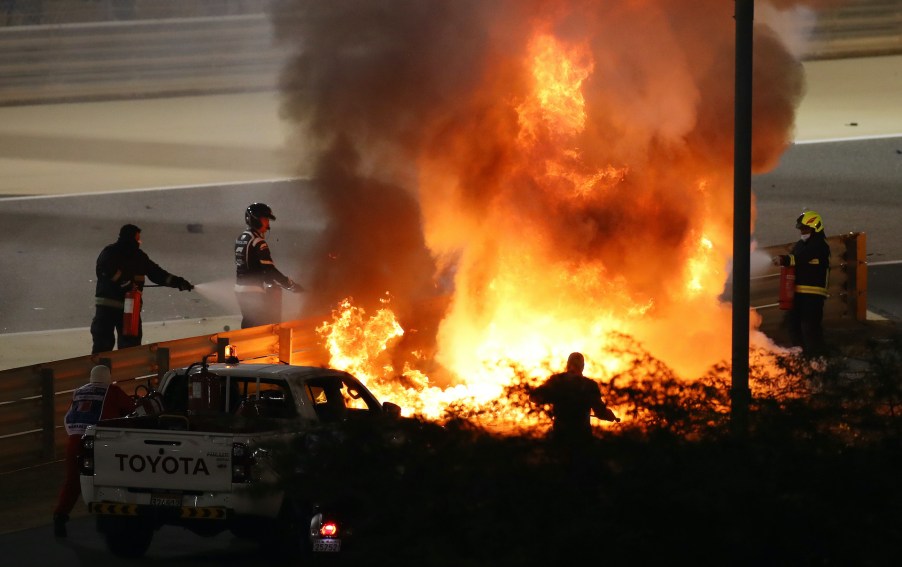
How Did Romain Grosjean Survive His Horrific Formula 1 Crash
Over the weekend, millions of Formula 1 fans worldwide tuned in to watch the Bahrain Grand Prix. What seemed like an ordinary race quickly turned a horrific turn as one of the drivers crashed into one of the barriers. The car in question is the HAAS #8 driven by french F1 driver Romain Grosjean. Upon striking the metal barriers, the HAAS split almost in half, causing a massive explosion. Today we’re looking at how modern racing safety equipment allowed Grosjean to walk away with minor injuries.
It is important to note that the video linked below includes some potentially graphic images of the actual crash.
This is one of the worst crashes in Formula 1 history
There is no getting around it; Grosjean’s accident is one of the worst in Formula 1 history. Although the crash’s specifics are currently under investigation by the FIA, we know a few details for sure. We know the crash began as Grosjean swerved across the track. He accidentally came in contact with the Alpha Tauri driven by Daniil Kvyat. Shortly after, Grosjean was sent straight into the metal barriers. Although no official speed has been confirmed for the crash, an FIA spokesperson told Sky News that the crash measured around 53g’s of force. To put that into context, a fighter pilot will routinely experience around 9g’s of force, says SandBoxx.
Despite the massive forces experienced, the French formula 1 driver managed to maintain consciousness. This is important because as the HAAS smashed into the barrier, it split in half and immediately caught fire. Thankfully, Grosjean was able to undo all of the Formula 1 car’s safety belts and crawl out. Despite his quick movements, Grosjean still spent around 20 seconds in the fiery HAAS before leaping to safety. Aside from the fire, crawling out of the burning car was no easy feat. Thanks to the barrier structure, the HAAS ended up wedged into the metal barriers. Thankfully, Grosjean was able to walk away from one of the worst Formula 1 crashes ever seen with minor injuries.
The HAAS’ halo safety structure saved Grosjean

Although Formula 1 remains an incredibly dangerous sport, it has gotten much safer over the years. In 2018, Formula 1 implemented the use of a halo protection system. In short, the halo, like the name suggests, creates a structure that surrounds the driver’s head. This system protects against debris and on-track accidents. According to the FIA, the protection system became mandatory for all participating teams to integrate. According to News 18, the halo utilizes titanium in its construction, ensuring that it is strong and lightweight. News 18 also reports that the halo can withstand up to 12,000 kg of weight, or about 26,455 lb.
The result is that as the Formula 1 car collided with the metal barriers, Grosjean’s head didn’t make contact with the structure. Instead, the halo took the grunt of the force. Surprisingly as you can see from the image above, the halo itself did not collapse during the crash, which not only kept Grosjean safe but allowed him an easier path out of the burning car.
According to ESPN, many Formula 1 fans and drivers alike complained about the halo’s implementation in 2018. However, yesterday’s crash definitively proves that the crash would’ve most likely been fatal without its inclusion.
The fire-proof race suit meant Grosjean was able to escape

Surviving the impact of this Formula 1 crash is only half the battle. That’s because Grosjean sat in the fiery car for almost 20 seconds. Had he lost consciousness during the impact, the French racing driver would’ve sat in the fire until the on-track staff was able to put it out. Grosjean’s saving grace on this occasion was the combination of the halo and his fireproof racing suit.
According to RedBull, the fire-proof suits utilized by Formula 1 drivers combine layers of Nomex fabric that can withstand temperatures of between 600 and 800 degrees Celcius or about 1112 to 1472 degrees Fahrenheit. This specialized racing suit allowed Grosjean to make his escape without serious burns.
Thankfully, this Formula 1 crash has a somewhat happy ending as Grosjean is reportedly recovering well at the hospital and should be released fairly quickly, says NBC Sports.


